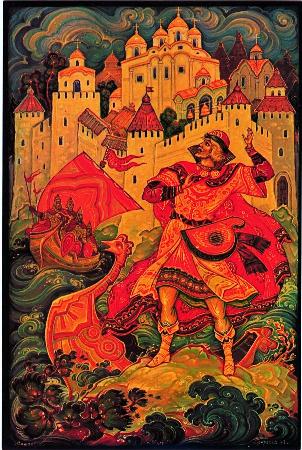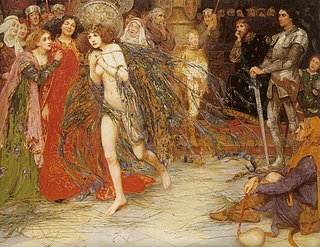Related Research Articles

The Child Ballads are 305 traditional ballads from England and Scotland, and their American variants, anthologized by Francis James Child during the second half of the 19th century. Their lyrics and Child's studies of them were published as The English and Scottish Popular Ballads. The tunes of most of the ballads were collected and published by Bertrand Harris Bronson in and around the 1960s.
Sir Aldingar is Child ballad 59. Francis James Child collected three variants, two fragmentary, in The English and Scottish Popular Ballads. All three recount the tale where a rebuffed Sir Aldingar slanders his mistress, Queen Eleanor, and a miraculous champion saves her.

Sadko is the principal character in a Russian medieval epic bylina. He was an adventurer, merchant, and gusli musician from Novgorod.
"Allison Gross" is a traditional ballad, catalogued as Child Ballad #35. It tells the story of "the ugliest witch in the north country" who tries to persuade a man to become her lover and then punishes him by a transformation.
"The Laily Worm and the Machrel of the Sea" is Child ballad number 36.

"Hind Horn" is a traditional English and Scottish folk ballad.
"The Queen of Elfan's Nourice" or "The Queen of Elfland's Nourice" is Child ballad number 40, although fragmentary in form.
Fair Annie is Child ballad number 62, existing in several variants.
"The Twa Magicians", "The Two Magicians", "The Lady and the Blacksmith", or "The Coal Black Smith" is a British folk song. It first appears in print in 1828 in two sources, Peter Buchan's Ancient Ballads and Songs of the North of Scotland and John Wilson's Noctes Ambrosianae #40. It was later published as number 44 of Francis James Child's English and Scottish Popular Ballads. During the 20th century, versions of it have been recorded by a number of folk and popular musicians.
The Gay Goshawk is Child ballad number 96.
"The Fair Flower of Northumberland" is a folk ballad.

Fause Foodrage is a Scottish murder ballad of the 17th or 18th century. It was first printed by Walter Scott in Minstrelsy of the Scottish Border (1802). Scott cited Elizabeth, Lady Wardlaw as the ballad's probable author.

"The Boy and the Mantle" is Child ballad number 29, an Arthurian story.
"Gil Brenton" is Child ballad 5, Roud 22, existing in several variants.
"The Marriage of Sir Gawain" is an English Arthurian ballad, collected as Child Ballad 31. Found in the Percy Folio, it is a fragmented account of the story of Sir Gawain and the loathly lady, which has been preserved in fuller form in the medieval poem The Wedding of Sir Gawain and Dame Ragnelle. The loathly lady episode itself dates at least back to Geoffrey Chaucer's "Wife of Bath's Tale" from The Canterbury Tales. Unlike most of the Child Ballads, but like the Arthurian "King Arthur and King Cornwall" and "The Boy and the Mantle", "The Marriage of Sir Gawain" is not a folk ballad but a song for professional minstrels.
"Earl Brand" is a pseudo-historical English ballad.
"Young Andrew" is a folk song catalogued as Child ballad 48.
"The Carnal and the Crane" is Child Ballad 55 and a Christmas carol. It depicts a conversation between two birds—apparently, although the species of the "carnal" has never been identified with any certainty, though crow is generally assumed.
Clerk Saunders is Child ballad 69. It exists in several variants.
"Bonnie Annie" is a folk ballad recorded from the Scottish and English traditions. Scottish texts are often called Bonnie Annie or The Green Banks of Yarrow, English texts are most often called The Banks of Green Willow. Other titles include The Undutiful Daughter, The High Banks O Yarrow, The Watery Grave, Green Willow, There Was a Rich Merchant that Lived in Strathdinah and The Merchant's Daughter.
References
- ↑ Francis James Child, English and Scottish Popular Ballads, "Brown Robyn's Confession"
- 1 2 Francis James Child, The English and Scottish Popular Ballads, v 2, p 13, Dover Publications, New York 1965
- ↑ Francis James Child, The English and Scottish Popular Ballads, v 1, p 245, Dover Publications, New York 1965
- ↑ Francis James Child, The English and Scottish Popular Ballads, v 2, p 15, Dover Publications, New York 1965